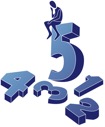How will you know when students have learned the basic facts?
Traditionally, students "knew" their basic facts if they could successfully complete all the basic facts for an operation in some predetermined time period. For example, some schools require 100 addition facts to be completed in 2 or 3 minutes. In other words, speed, with a reasonably high level of accuracy, is the primary criteria.
However, assessment on the basic facts needs to include a variety of tasks. For example, drill (timed tests) can provide information about the speed and accuracy of students for basic facts. But Brownell's second goal would be ignored. Teachers should also identify the thinking strategies that students are using. They should be able to use some efficient thinking strategy for any basic fact that is presented. One way to determine how the students are thinking is to provide a few word problems in an interview. Ask the student to think aloud as they solve each of the problems. Probing, as necessary, can provide the teacher considerable information about the thinking of the student. If there is a question about the use of a strategy, the teacher can suggest that the student use that strategy while solving a different problem.
Another aspect of understanding addition and subtraction facts is to determine if the students understand the part-part-whole concept. Give the parts and whole, using larger numbers. Choose numbers where the students will not know the answer to the problem. For example, the parts are 19 and 16 and the whole is 35. Then ask some related questions. What is 35 - 19?
Over fifty years ago, William Brownell indicated that his goals for teaching basic facts were to have students be able to provide (1) an immediate response and (2) an explanation or verification that the fact is correct. Those two goals are still appropriate today. The second goal may not be as commonly accepted today as the first one is, but it is important. Research has shown that students, who can explain or verify basic facts, learn the facts sooner, are able to use them in mental computation with larger numbers, and remember them longer. Also, without these student explanations, it is more difficult for teachers to know if students understand, just know rotely, or were guessing.
Students who know the basic facts will be able to respond to facts quickly (about 3 seconds per response). They will be highly accurate. If drill is postponed until after the students can use an efficient thinking strategy, then the practice that drill provides enables students to be more than 95% accurate. Furthermore, they will be able to explain many of the efficient thinking strategies as ways in which they solve basic fact problems. The students need to be flexible enough with the use of these strategies so they decide which strategy will work best in a given situation.
If students have learned the basic facts, what else will the be able to do?
Students, who have just rotely memorized the basic facts without being able to justify their answers or explain their thinking, will not be as adept at using their knowledge in new situations. On the other hand, when students have learner efficient thinking strategies, they can use that same thinking in many different situations. For example, if they can count on, they can easily solve 68 + 3 almost as easily as 8 + 3. Similarly, 28 + 6 is not much more difficult than 8 + 6. The thinking strategies are powerful ways for them to solve many problems with larger numbers. In other words, these students will be much better at mental computation.
Students, who understand the part-part-whole concepts, will be able to write number sentences that make sense to them based on parts and wholes. And they will be able to easily determine whether to add or to subtract when they attempt to solve a word problem. If they know both parts, they simply add to find the whole. If they know the whole and one part, they subtract to find the other part. This provides them a powerful way to solve addition and subtraction word problems.
Perhaps the most important attribute of students, who have met the goals described above, is the mathematical power that they develop. They feel confident that they can make sense of numbers. They are competent because they can accurately solve basic fact problems and many other problems as well. And they have developed the perseverance to try to make sense of problems involving numbers. They do not quit trying to solve a problem just because they do not remember the answer. These students have the mental tools to be successful in mathematics.

